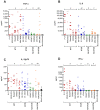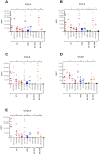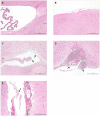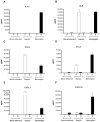Virulence Studies of Different Sequence Types and Geographical Origins of Streptococcus suis Serotype 2 in a Mouse Model of Infection
- PMID: 27409640
- PMCID: PMC5039428
- DOI: 10.3390/pathogens5030048
Virulence Studies of Different Sequence Types and Geographical Origins of Streptococcus suis Serotype 2 in a Mouse Model of Infection
Abstract
Multilocus sequence typing previously identified three predominant sequence types (STs) of Streptococcus suis serotype 2: ST1 strains predominate in Eurasia while North American (NA) strains are generally ST25 and ST28. However, ST25/ST28 and ST1 strains have also been isolated in Asia and NA, respectively. Using a well-standardized mouse model of infection, the virulence of strains belonging to different STs and different geographical origins was evaluated. Results demonstrated that although a certain tendency may be observed, S. suis serotype 2 virulence is difficult to predict based on ST and geographical origin alone; strains belonging to the same ST presented important differences of virulence and did not always correlate with origin. The only exception appears to be NA ST28 strains, which were generally less virulent in both systemic and central nervous system (CNS) infection models. Persistent and high levels of bacteremia accompanied by elevated CNS inflammation are required to cause meningitis. Although widely used, in vitro tests such as phagocytosis and killing assays require further standardization in order to be used as predictive tests for evaluating virulence of strains. The use of strains other than archetypal strains has increased our knowledge and understanding of the S. suis serotype 2 population dynamics.
Keywords: Streptococcus suis serotype 2; blood bactericidal assay; inflammation; mouse model; phagocytosis; sequence type; virulence.
Conflict of interest statement
The authors declare no conflicts of interest.
Figures









References
-
- Goyette-Desjardins G., Auger J.P., Xu J., Segura M., Gottschalk M. Streptococcus suis, an important pig pathogen and emerging zoonotic agent—An update on the worldwide distribution based on serotyping and sequence typing. Emerg. Microbes. Infect. 2014;3:e45. doi: 10.1038/emi.2014.45. - DOI - PMC - PubMed
-
- Okura M., Lachance C., Osaki M., Sekizaki T., Maruyama F., Nozawa T., Nakagawa I., Hamada S., Rossignol C., Gottschalk M., et al. Development of a two-step multiplex PCR assay for typing of capsular polysaccharide synthesis gene clusters of Streptococcus suis. J. Clin. Microbiol. 2014;52:1714–1719. doi: 10.1128/JCM.03411-13. - DOI - PMC - PubMed
Grants and funding
LinkOut - more resources
Full Text Sources
Other Literature Sources

